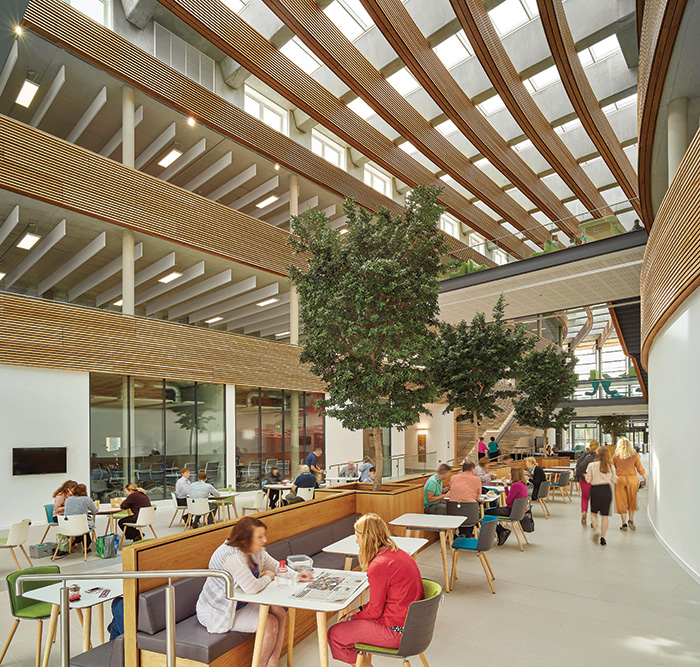Three Sustainability Concerns That Should Be Top Of Mind For Every FM

Amid mounting climate risks and growing pressure to show progress on decarbonization goals, facilities managers are on the front line of making buildings more resilient and sustainable.
Their first-hand experiences of what’s needed to reduce carbon emissions, support retrofitting efforts and minimize disruption during ever more frequent extreme weather events make them a key voice in building the business case for sustainable buildings – not to mention a key player in implementing robust and timely sustainability and resilience strategies.
JLL’s recent report, ‘The commercial case for making buildings more sustainable’, outlines three factors that are increasingly influencing the business case for creating a more resilient and sustainable built environment. The mounting costs from climate risk, increased demand for sustainable buildings and tougher incoming regulation are starting to have an impact on buildings, their owners and their occupiers today, and this will be increasingly pronounced in the coming years.
For facilities managers, these areas are ones to watch as they adapt building operations and protocols to ensure the spaces they manage are meeting evolving expectations and supporting ‘business as usual’ in a changing world.
Mounting Costs From Physical Climate Risks

The damage caused by increasingly frequent and intense weather events is a mounting concern for real estate. From storms and flooding to lengthening heatwaves, these events have significant repercussions for buildings, both in terms of their immediate operations and their longer-term structural integrity and resilience. Industry analysis estimates that costs from flood damage in the U.S. will reach US$16.9 billion a year by 2052 and affected businesses would collectively lose 4 million days to recovering from flood events.
However, for some companies, climate risk remains a blind spot. While JLL’s research found that 78% of investors and 83% of occupiers identify climate risk as a financial risk, only 23% of executives are contingency planning for disruptions in the next 12 to 18 months, according to a PwC Survey.
Facilities managers need to prepare for increasing climate risk as disruption to operations and property downtime will result in reduced revenues and increased supply chain costs. These risks also may lead to higher operating costs given that resources such as energy and water could become more expensive for companies without appropriate mitigation measures.
Better risk assessment and mitigation will be crucial: Facilities managers need to be proactive in identifying the risks and vulnerabilities associated with extreme weather events and climate change. Business continuity planning will need to become more robust and collaborative while regular inspections, closer monitoring of systems and more data driven, predictive maintenance, can help to support the resilience and safety of the facilities they manage. Promoting sustainable practices that encourage resource efficiency could be another important aspect to boost long-term resilience.
Rising Demand For Sustainable Buildings

The way occupiers think of sustainable buildings is changing. Historically, green certifications that are primarily design and construction-based were the primary mark of sustainable buildings. As corporates look to advance on climate goals and net zero targets, operations and building performance will increasingly become top of mind.
This means improving energy efficiency, switching to renewables and even implementing measures that support nature and biodiversity.
In many global markets, rising corporate demand for buildings aligned with climate targets will have an impact on office market leasing dynamics. Across 20 major office markets, including New York, Paris and Singapore, only 34% of future demand for low-carbon workspace will be met in the next several years, according to the research. In other words, for every 3 square meters of demand, only 1 square meter is in the current pipeline.
This presents an opportunity for proactive facilities managers to take action and add value by making their buildings more sustainable, which can lead to attracting high-quality tenants, higher occupancy levels, and other financial benefits.
JLL’s research shows that occupiers will pay more for energy-efficient buildings, especially if they expect significantly lower operating costs. Targeting emissions reductions and improved resilience in real estate operations also present more immediate and controllable opportunities to advance on ESG goals, compared to more complex Scope 3 emissions across supply chains.
More Restrictive Regulations

Although market forces driving investors and occupiers are moving faster than regulations right now, new legislation is on the horizon at an international, national and most stringently at a city level.
The report assesses policies from 16 global cities covering carbon, energy, buildings circularity, biodiversity and resilience and reveals a wide spectrum of commitment and action. For instance, ‘Climate Progressive’ cities such as New York, Paris and Amsterdam are rolling out an array of policy instructions covering new and existing commercial real estate. At higher government levels, disclosure mandates like the EU’s Corporate Sustainability Reporting Directive (CSRD) will require greater transparency around energy use and broader resource conservation, where facility management will play a key role.
Facilities managers need to stay informed about incoming and evolving regulations related to building performance standards and carbon emissions to ensure their buildings meet or exceed the required standards. Failure to comply with these regulations can result in financial penalties and reputational damage.
As the focus on sustainable and resilient buildings grows, taking a proactive approach will help buildings to remain competitive and compliant. By implementing the right measures in the right way at the right time, facilities managers can minimize the impact of physical risks on buildings and reduce disruption to business and building operations while meeting the growing demand for sustainable spaces.
Click the article to enlarge it.


























































